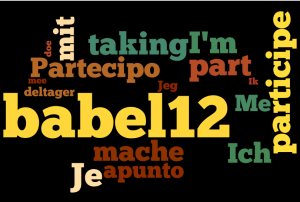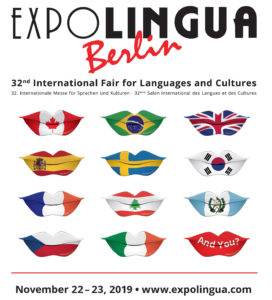Working Together: Multilingualism & Europe
 “Multilingualism is one of the cornerstones of Europe and at the same time one of the last true barriers between people. Language ties people together in their families and helps to define their identity and community. These are only a few reasons to keep the cultural heritage of multilingualism alive. A problem that is definitely related to the lack of a common language is the lack of a European identity. For example, I cannot imagine how a future European foreign policy should be able to react quickly and with one voice in times of an international crisis. Language learning and human translation are one part of the solution. Another part will be translation technology that is seamlessly integrated into our daily life. One of my dreams would be the possibility to be able to understand any person in Europe via translation technology that mimics the person’s voice, accent, tonality, etc.”
“Multilingualism is one of the cornerstones of Europe and at the same time one of the last true barriers between people. Language ties people together in their families and helps to define their identity and community. These are only a few reasons to keep the cultural heritage of multilingualism alive. A problem that is definitely related to the lack of a common language is the lack of a European identity. For example, I cannot imagine how a future European foreign policy should be able to react quickly and with one voice in times of an international crisis. Language learning and human translation are one part of the solution. Another part will be translation technology that is seamlessly integrated into our daily life. One of my dreams would be the possibility to be able to understand any person in Europe via translation technology that mimics the person’s voice, accent, tonality, etc.”
Aljoscha Burchardt, October 2012
“Are we too late or well ahead of time?” – referring to changes that the industry is going through. Has there been any more light shed on the situation over the past two years?
Aljoscha Burchardt: Definitely, yes. In the last two years, there has been a lot of activity in this area. This year, I will chair the final panel and as panellists I will have representatives of two EU-funded projects that work on technologies and resources supporting audio-visual translation. I feel that there is an increasing openness towards changing workflows and smarter environments. I also think that a side-effect of the recent crowd-sourcing initiatives is that consumers are getting much more aware of the difficulty and value of the proper treatment of language.
What would you say is the most influential reason for today’s multilingualism?
Aljoscha Burchardt: Apart from the more emotional reasons I mentioned, there is the dimension of basic human rights. UNESCO and others are very clear in that, say, the enjoyment of the right of information access and utterance of your political will are tied to language. By the way, I am very happy that Europe is not a dictatorship that can force everybody to speak the same language. Still, I see the global strategic disadvantage as compared to the US or China that do not have this communication problem. Other multilingual regions such as India and South Africa are actually much more aware of the need to react. They have set up strong programs for research and technology development.
You are going to be talking about “smarter working environments” at the conference. In which ways would you say working environments are becoming smarter?
Aljoscha Burchardt: I sometimes compare it to the working place of a graphic designer or journalist who has many more possibilities for artistic creativity today than in the past. You do not need an expensive studio and a huge team of assistants and copy-writers today to produce your own creations. Today, we are pursuing a much more human-centric strategy for technology development. In my own research in projects on quality translation such as taraXÜ or QTLaunchPad, we strongly cooperate with language service providers and include freelance translators into the improvement of machine translation technology. In that sense, the working environments get smarter by learning from humans.
The new generation of technological support will lead to a new division of labour between humans and technology and to new workflows. How are working environments changing? And what will this change mean for translators?
Aljoscha Burchardt: If I talk to freelance translators and language service providers, I often hear that tools are not integrated in the way they should be. In my opinion, the next step will be the design of really ergonomic working environments that support human translators in their daily work by taking over routine tasks and leaving the artistic freedom to the human. I think of evolution rather than revolution. If you think of the “type ahead” functionality in your Google query window, you see that this little helper really saves time. Likewise, a smarter integration of time codes, translation memories, terminologies, machine translation, etc. could even today help translators a lot. One consequence for the translators or computer users in general should be that technology gets easier to use and thus de-focussed. If you see how a four-year-old child operates an iPad by trial and error, you might see what I mean.
With automatic translation technologies becoming available on current smart phones, such as apps capable of Photoshoping translations into a real-time photo image, how far off would you say that we are from something like the commercial release of a babel fish-like, in-ear, audio-based auto translator?
Aljoscha Burchardt: Actually, some prototypes are already emerging on the market. But I would expect that it will take another five to ten years before the technology will be mature enough for me to appreciate it and really use it. For it to be truly as good as a human? Who knows? The current functionality of Apple’s Siri, e.g., is rather limited. Still, it is a technological masterpiece.
by William Whiteman
First publication: http://languages-media.com, October 2012



